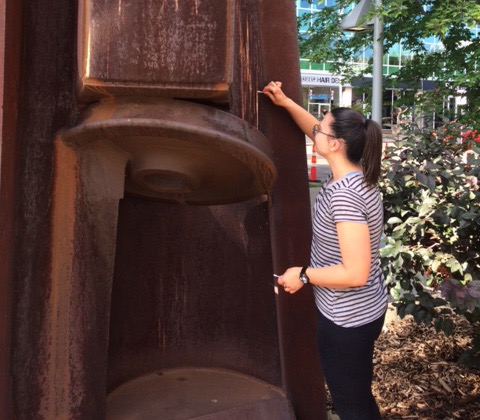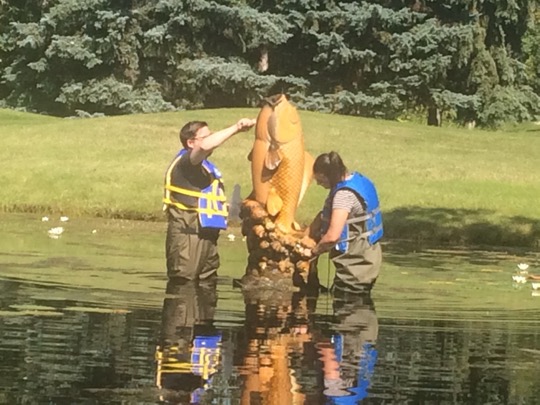UAM Summer Internship 2017: Saved the Best for Last...
Jean Middleton - 1 September 2017
The University of Alberta Art Collection (UAAC) contains thousands of works of art. Those that are most visible to the majority of people at the University of Alberta are the works of public art installed across campus. The collection of public art includes many sculptures such as InScope, next to the Li Ka Shing Centre for Health and Research Innovation, and The Visionaries, located in the President’s Circle at the south entrance to the Senior Administration Building. Because these sculptures are outdoors they require annual condition checks and cleaning to protect them from deterioration. Cleaning the public art on campus was an opportunity for me to work in one of my favourite areas, preventative conservation, to make sure the sculptures were free from anything that could be harmful to them. The first step was completing condition checks of all public art to determine cleaning requirements and assess if any further maintenance was needed, such as re-waxing bronze sculptures. Most sculptures had cobwebs and debris, including seeds, leaves, and dirt, which required dry cleaning with brushes and, at times, a vacuum. Others had bird droppings and other accretions, a fact that I’ve been reminded of often since I began my internship. These needed a wet clean using cotton swabs and a mixture of Orvus WA Paste (a conservation-grade detergent) and water. During these condition checks, we also made a note of what extra supplies were needed to complete the cleaning, such as a ladder for areas beyond our normal reach and a scalpel for removing rubber strips that we found adhered to two sculptures. Once we completed the checks, we reviewed the cleaning needs with the Assistant Curator of UAAC and also updated him on any further maintenance that we noted during the checks.

Condition checks were incredibly important for two reasons: to update the condition of the public art in our database and to ensure we had all of the necessary supplies for cleaning each sculpture. For the sculptures that had bird droppings, we dipped cotton swabs into the Orvus WA and water solution and then used a U-shaped gesture to remove as much of the bird droppings as possible without ingraining them into the sculptures. It was also important to continually rotate the cotton swabs and to replace them often with new ones so as not to smear the bird droppings on the sculptures. Bird droppings are so often seen on outdoor art and it is easy to forget that they are actually acidic and react negatively with many materials such as unfinished metal, so cleaning the sculptures prevents further deterioration. We then had to rinse the localized areas we cleaned with water to remove any residue from the detergent and to ensure there were no tide lines. We then used soft-bristled brushes to remove debris, such as cobwebs, seeds, leaves, and gravel. If a sculpture was painted or sealed with an impermeable coating, we gently “washed” soiled areas with warm water and microfibre cloths.


The most exciting part of public art cleaning and I’m sure every University of Alberta Museums’ Intern will agree, was wading into a pond to clean two marble fountains. The pond and fountains are located at Soaring, which was the home of philanthropists Sandy and Cécile Mactaggart, whose numerous donations to the University of Alberta include the Mactaggart Art Collection. Cleaning the fountains, which are in the shape of carp and are part of the Mactaggart Art Collection, was easily one of the most fun tasks I got to do this summer. I got to wade into the pond in hip waders, armed with a toothbrush and a spray bottle of cleaner. The cleaner, D2 Biological Solution, is a non-hazardous biodegradable solution that does not negatively impact the pond's ecosystem or the marble fountains. D2 Biological Solution is highly effective in cleaning the algae off the carp and also inhibits further growth.
After cleaning I updated the database records for each of the sculptures using the information collected during the condition checks. I also entered the details of how we cleaned each work to keep track of the conditions and conservation activities for each of the sculptures over time.